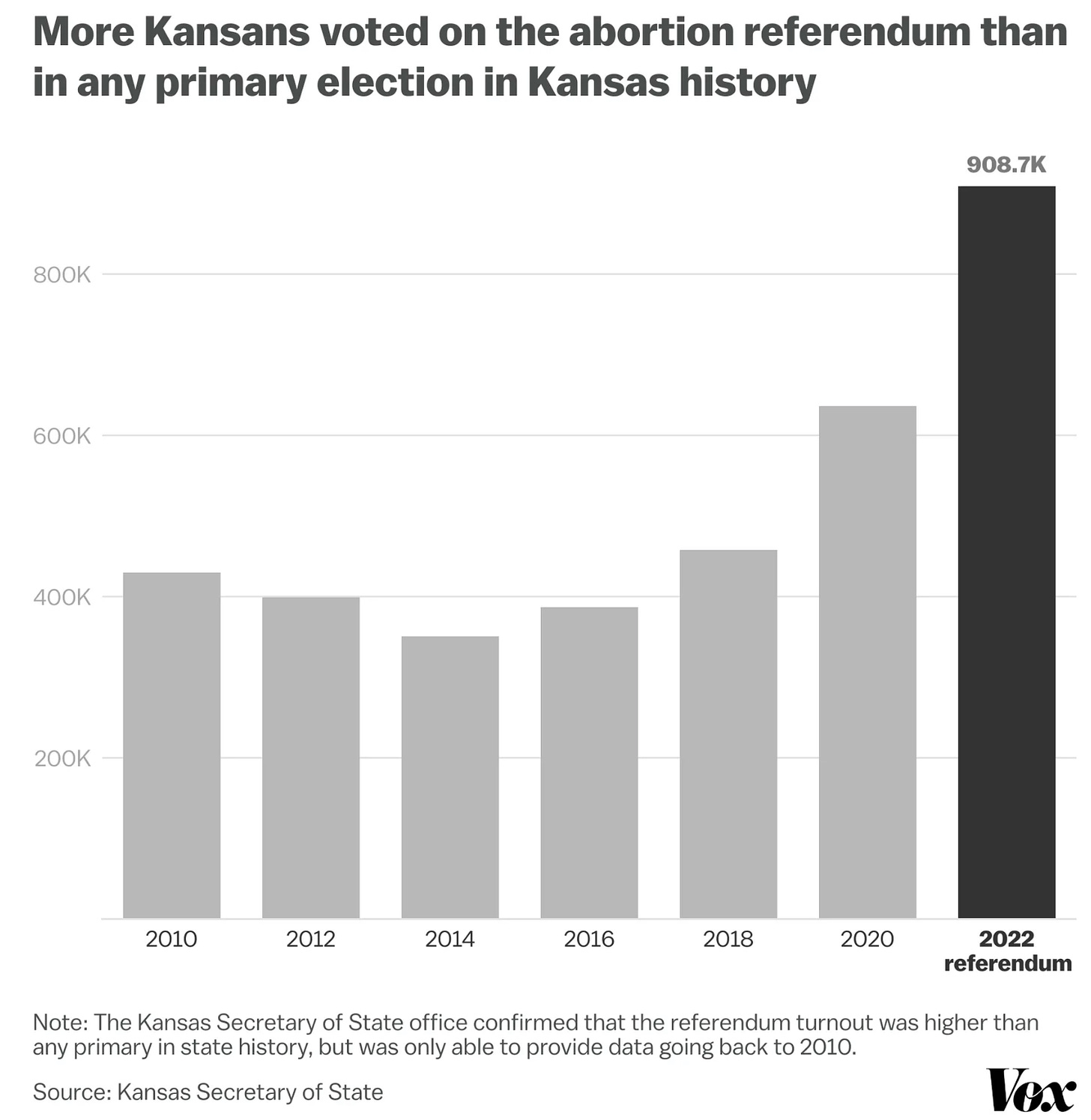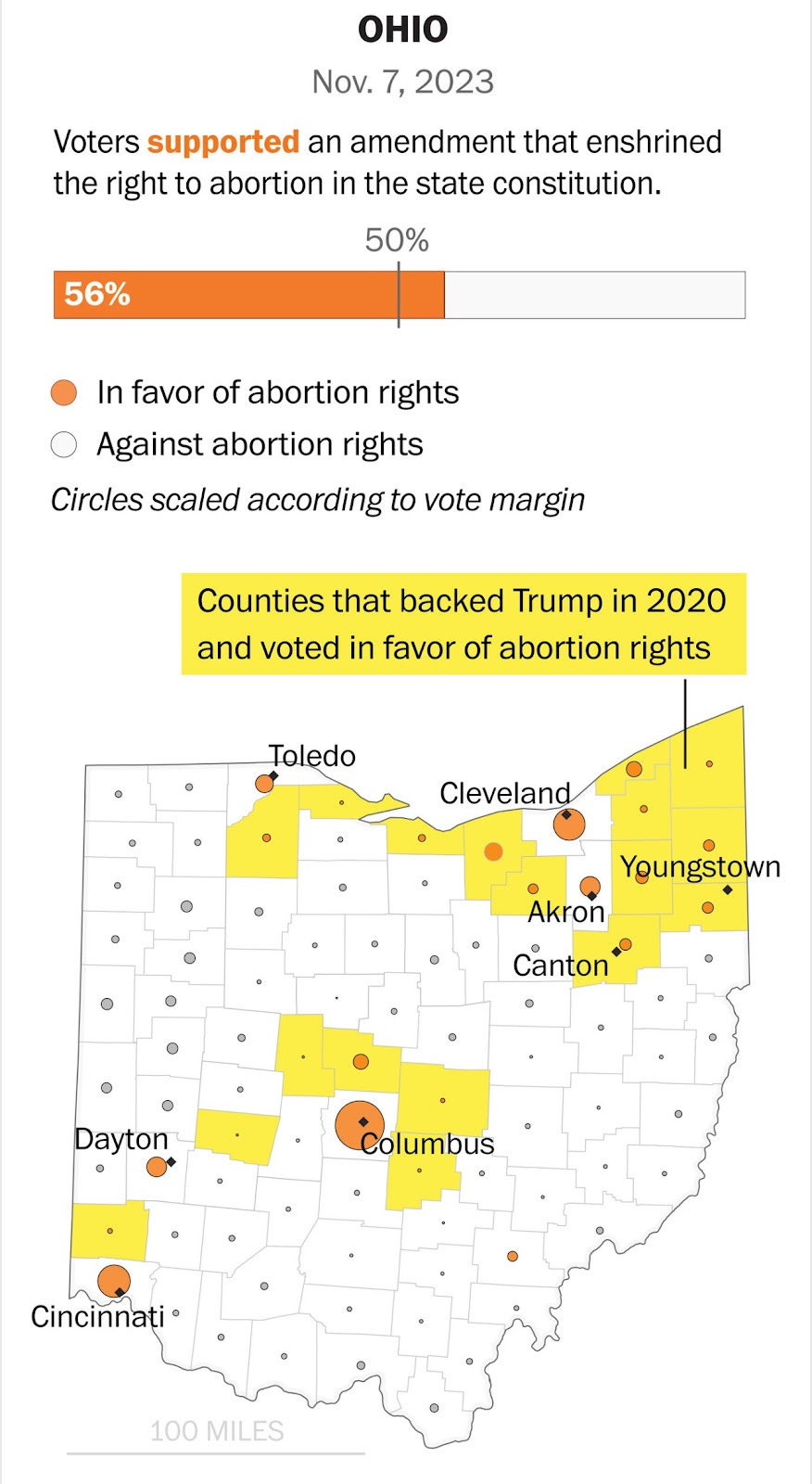Abortion Rights Will Wedge the GOP Brutally in 2024
Democrats' plan to wedge Republicans on abortion rights with 2024 ballot initiatives is straight out of the Republican playbook.

I remember election year 2004. Sen. John Kerry was looking to unseat incumbent president George W. Bush. It was a tight race, but thanks to Karl Rove, the Republicans had a “wedge” issue up their sleeve: gay marriage.
Back then, Ohio was considered a swing state, if you can believe it. It was crucial to the electoral chances of both candidates. So the GOP did something very cruel, yet very smart: They made same-sex marriage a ballot issue in Ohio. One way, they figured, to turn out the Evangelical right wing of their party was to put that controversial measure up for a vote. It also “wedged” off socially conservative Democrats, who back then were largely opposed to same-sex marriage.
And it wasn’t just Ohio. Same-sex marriage ballot initiatives wound up appearing in 11 states, and in that horrible year they passed in all of them. Democrats and independents in those states even voted for the measures in large numbers. It was heartbreaking. The LGBTQ community, already attacked and marginalized, was used as a political tool. Our marriages and loving relationships were sacrificed in order to whip up hatred and bigotry. And sadly, it provided Bush with enough momentum to win Ohio and keep the White House.
But turnabout is fair play. If the special and general elections since the Dobbs decision overturning Roe v. Wade have shown us anything, it is that abortion is the “wedge” issue for Republicans—and it could cost them dearly if Democrats successfully deploy it. This is hard-nosed politics, yes. But ballot measures on abortion next year will juice turnout among progressive voters who want to see constitutional and legal protections for abortion, perhaps even to see Roe enshrined in law. Such ballot measures are truly a win-win for Democrats, and Republicans are deeply worried.
In The Big Picture today, writer Jay Kuo discusses the history of abortion measures since Dobbs and the various plans Democrats have to use abortion as a wedge issue for the forces of progress, to protect the reproductive rights of women, and score even more victories for bodily autonomy. Played correctly, Democrats could drive the wedge strategically to increase progressive voter turnout and bring over more moderate abortion rights voters in key states, including important presidential and senate battlegrounds.
I say bring it on.
— George Takei
A quick pledge break before we dive in! If you’ve been meaning to support our work, now’s a great time!
The first startling result on abortion came from Kansas, a deeply red state. Just months after Dobbs was decided, Kansas shocked the world with a lopsided vote, where the electorate decided 59 to 41 percent—a whopping 18 point margin—to reject a measure that would have declared that the Kansas state constitution did not protect the right to an abortion.
Not only did the measure go down to a resounding defeat, turnout was through the roof.
Activists took note.
If abortion rights could hit numbers like that in Kansas, it could happen elsewhere. In the lead up to the 2022 midterms, campaign strategists conducting focus groups were drawing the same conclusion: Voters, especially women, were furious about the Dobbs decision. And more importantly, the loss of abortion rights was persuading swing voters.
Abortion wound up being a large if not the largest factor in the 2022 midterm elections, especially in the battleground states of Michigan, Wisconsin, Arizona, and Pennsylvania, where the right to abortion was left vulnerable after Roe was struck down. In those states, often all that stood in the way of draconian abortion bans becoming law again was the veto power of the governor or a few votes in the state legislature.
Abortion rights advocates understood the assignment. Pro-choice candidates won resounding victories in each of these critical states. They claimed all four governorships, and in some cases, such as in Michigan and Pennsylvania, they even flipped control of one or both chambers of the legislature.
Then there was Wisconsin in 2023.
Wisconsin is a place where statewide elections are usually decided by a percentage point or less. In 2020, the state very narrowly went to Biden. In 2022, Lt. Gov. Mandela Barnes lost his senate race to Sen. Ron Johnson by just one percentage point.
That’s why what happened in April of 2023 was so astonishing.
A pro-choice state Supreme Court justice candidate, Janet Protasciewisz, ran against an extremist anti-choice MAGA candidate for an open seat on Wisconsin’s highest court. At stake was the deciding majority, which would determine crucial questions around gerrymandering and abortion. In fact, Wisconsin had an abortion ban law on the books from the 19th Century that sprung back into life when Roe was overturned. Whether abortion was a right guaranteed by the state constitution was still a legal matter to be decided.
Protasciewicz obliterated her opponent by 11 points, not by the normal one-point margin. The pro-reproductive rights wave that had begun with Kansas and carried through the midterms was showing no sign of abating.
Which brings us to last week’s elections.
Republicans are scrambling for new footing.
The GOP began to understand that sending the question of abortion “back to the states” after Dobbs had proven a terrible idea politically, especially in states where wide swaths of the electorate are worried about losing these rights and are angry and highly motivated to vote to protect them.
This is especially true among key demographics, such as suburban women, whom the GOP needs in their column, and younger voters who have been turning out in high enough numbers to actually cancel out the Boomer and Silent Generation voter blocks over the age of 65.
Republicans had hoped that a “compromise” position, with a ban after 15 weeks, would win over voters skeptical of GOP intrusions into their personal medical decisions. But as it turned out, voters weren’t so keen on this either.
Virginia was a nearly perfect test case.
Ahead of the November 7 election, Governor Glenn Youngkin of Virginia, a fairly popular Republican incumbent, ran on the express promise that he would try to implement a 15-week abortion ban if the voters would hand the GOP a trifecta of control in the state capital. He managed to unite Republicans in the state around this idea, even though many actually wanted to go further with restrictions.
To help achieve this shift in power, Youngkin dumped $30 million into state legislative races, hoping that much money would help the message around a 15-week abortion “limit” resonate with voters.
But instead of handing Youngkin unchecked political control, voters in Virginia handed him a stinging defeat. The GOP not only failed to flip the State Senate, it also lost control of the House of Delegates.
There was also Ohio.
Ohio is no longer a swing state. It’s considered pretty solidly red, and Trump won it comfortably by eight points in 2020. And yet, last Tuesday Ohio voters overwhelmingly approved a ballot measure to amend the state constitution to expressly permit abortions up to the point of fetus viability—essentially codifying the protections of Roe.
That made it the seventh state since Roe fell where voters cast their ballots expressly in favor of reproductive rights.
In 2023, the fight to protect abortion rights in Ohio was a winning issue in key suburban areas of the state won by Trump in 2020, according to data reported by The Washington Post, represented in yellow in the map below:
GOP watchers such as Rick Wilson of the Lincoln Project noted that this victory couldn’t have been possible without at least 25 percent of Republican voters voting in favor of protecting abortion rights.
And there was Kentucky.
Gov. Andy Beshear of Kentucky is something of a unicorn: a Democratic governor of a deeply red state, which voted for Trump by 26 points. And yet, last week he handily won reelection. One of the reasons is abortion.
Kentucky has a draconian, total abortion ban in place, one that snapped back into law once Roe fell. Beshear has campaigned hard against it, including an ad featuring a survivor of rape by her own stepfather.
“This is to you, Daniel Cameron,” the woman in the ad says, referring to Beshear’s Republican opponent. “To tell a 12-year-old girl she must have the baby of her stepfather who raped her is unthinkable.”
Yet that is precisely the GOP’s position, and it is causing them to hemorrhage voters. But there is no consensus within the party over what to do about it. Republicans remain starkly divided over whether the party should seek to grow a consensus over a national ban or simply leave the issue with the states as the Supreme Court had determined in Dobbs.
Abortion on the forefront in 2024.
The proof is in now, and it’s clear that abortion is a potent wedge issue that can cause even red states to vote for abortion rights and for pro-abortion rights candidates. It can overcome much-vaunted “red waves” and supercharge turnout among women and young voters. And importantly, it can cause a certain number of right-leaning independents and Republicans to vote Democratic.
Armed with this knowledge, Democrats have worked with abortion rights advocates to prepare a plethora of abortion measures next year, some of them in key battleground states.
By some counts, there may be as many as eight states with abortion measures on the ballot in November. As Axios reported, this includes the state of New York, which may have six very swingy districts depending on how a redistricting case shakes out.
In the electorally crucial states of Nevada and Arizona—the latter of which will see a huge, likely three-way battle over Kirsten Synema’s senate seat—abortion rights advocates are busy getting ballot measures ready to secure abortion rights in the state constitutions.
And even in deeply red Florida, which just passed a horrific six-week abortion ban, activists are preparing an abortion measure. Florida is interesting because Sen. Rick Scott may be among the more vulnerable incumbents in the Senate, and a big turnout in Florida could conceivably unseat him.
It’s the messaging, stupid.
While Democrats have a clear and effective messaging campaign, namely, to protect abortion rights from government overreach, Republicans are struggling to come up with theirs.
As the Washington Post noted, the Republican National Committee, led by Ronna McDaniel, believes the GOP should be aggressive on the issue and find a “consensus as a country” around a 15-week ban. But that didn’t work out so well in Virginia.
The hardcore extremists, represented by such groups as Susan B. Anthony Pro-Life America, believe that Republicans can paint Democrats as the extremists who want late-term abortions. Even though that messaging hasn’t succeeded, the group believes it could if it put “real advertising dollars behind it.”
So-called “moderates” in the GOP want to show how compassionate the party is by leaning into all the exceptions they would allow for things like rape, incest, or the life of the mother. They want to talk about “limits” and not “bans.”
But at the end of the day, women voters are being fairly clear about what they want: the government out of personal health care decisions. They want the old protections of Roe back, and they aren’t going to settle for less.
That could result in a surge in turnout and crossover voting in the states where the question is presented squarely. And that, in turn, could mean big Democratic victories in very tough, otherwise close contests.
Abortion is the wedge issue of 2024. And the GOP is likely to experience once more how powerfully it will drive itself through the Republican voter base.
* * *
Hi. It’s Jay Kuo. We are working hard in these troubling times to bring The Big Picture into focus. Many of you have asked how you can help our mission. The best way to do so is to support us with a paid subscription so we can keep our work going. If you’ve been meaning to upgrade to a paid account, there’s no better time than today!







